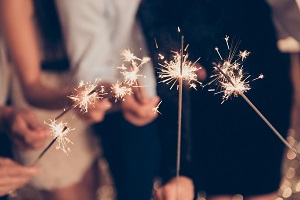MEDIA // NEWS

Pandemic Leads to More Fireworks- and Potentially more Injuries
July 02, 2020 at 12:00 AM EST.Americans across the country have been setting off more backyard fireworks in their communities than ever before. Public health officials are worried more homegrown displays could lead to higher rates of injury this summer.
In New York City, there was a 5000% increase in complaints about fireworks in June. More than 1,300 fireworks complaints were lodged during a two-week period. During the same time period last year, there were just 25 complaints. In Boston, there’s been a 2,300% increase from last year- 1,445 calls about fireworks in the first week of June this year versus just 22 during the same week last year.
There’s lots of theories of why the growing fireworks popularity- many of those theories are rooted in the pandemic. One is that with more people at home rather than at work or travelling, they have more opportunities to notice the noise. Cities in general are quieter with bars and restaurants closed or at half capacity. Kids are stuck at home without school or friends around, and may find fireworks a fun distraction. Police could also be less inclined to enforce fireworks rules- between heightened workload due to protests, or in general a sense of \“at least its just fireworks\”, cops may be less motivated to police backyard fireworks displays.
Lastly, the cancellation of public fireworks displays across the country due to social distancing mandates could have a twofold impact the home displays: there are more fireworks available, and people are more apt to create their own display.
Health professionals are fearful of this uptick in backyard fireworks displays. They’re fearful that injuries will soar as amateurs who don’t know or practice fireworks safety set off explosions in neighborhoods around the country.
The most common fireworks injuries are burns to fingers, hands, arms and legs. Unfortunately, eye injuries are also fairly common, as recommended protective eyewear is often foregone by amateurs.
According to the U.S. Consumer Product Safety Commission, in 2017, there were eight deaths and more than 12,000 individuals sought treatment for fireworks-related injuries. As backyard displays skyrocket in popularity, you can also expect injuries to rapidly spike at the same rate. There are some steps experts suggest if you and your family or friends decide to host a backyard display:
- Be careful of large group gatherings. COVID-19 is still a threat, and regular social distancing precautions should be taken to lessen the risk of infection.
- Check local laws regarding displays. They’re illegal in some states, and understanding your local laws could prevent legal trouble.
- Make sure everyone around the display are aware that they are going to be set off ahead of time. Injuries don’t just happen to those lighting them; spectators or even just people walking by are also often subject to injury.
- Always be aware of where a firework is pointing, and make sure it is not facing any people, pets, or property.
- Having water or a fire extinguisher nearby is essential. In 2018, fireworks were responsible for an estimated 19,500 fires, according to the National Fire Protection Association.
- If a firework doesn’t light on the first try, don’t try to relight it. If it doesn’t light, that could point towards a malfunction, and it could become hazardous.
- While sparklers are typically thought of as safe for children, keep in mind that they can burn up to around 2,000 degrees. Never light them indoors, or allow very young children to handle them.
- Drugs/alcohol and fireworks never mix. Anyone impaired by alcohol or drugs should never handle- or even be too close- to a fireworks display.
In addition to these safety tips, it’s always important to keep an eye on children and pets during fireworks displays. Even if you’re not attending a display, even having them within your neighborhood can be extremely stressful for children and pets. Check on both to make sure the loud, unexpected noises and lights aren’t negatively impacting them.
